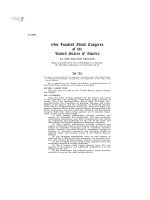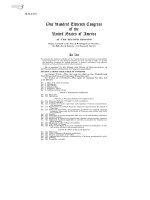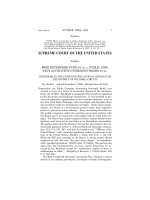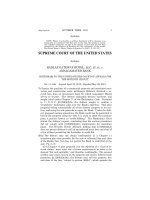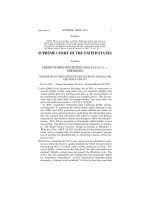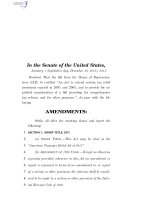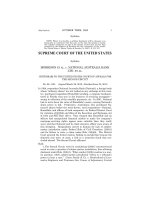Implementation of New Accounting,,Standards of the United States Washington _part3 pptx
Bạn đang xem bản rút gọn của tài liệu. Xem và tải ngay bản đầy đủ của tài liệu tại đây (953.31 KB, 11 trang )
.(.,/jr
‘6 ,.,e ,,
GENERAL ACCOUNTING OFFICE REPORT
Blank page
‘,
i
‘.
i” ‘
,.’ ‘.
’ ,
‘, ’ ., ‘. ‘,
.,
,,.,,,. ._
This is trial version
www.adultpdf.com
GENERAL ACCOUNTING OFFICE REPORT
IQ
I . ‘i
Comptroller General
of the United States
Washington, D.C. 20548
B-282041
The President
The President of the Senate
The Speaker of the House of Representatives
The Secretary of the Treasury, in coordination with the Director of
the Office of Management and Budget (OMB), is required to annu-
ally submit financial statements’ for the U.S. Government to the Pres-
ident and the Congress. ’
GAO is required to audit these statements.
This is our report on our audit of the financial statements of the ‘U.S.
government for fiscal year 1998.2
In summary, significant financial systems weaknesses, problems
with fundamental recordkeeping and financial reporting, incomplete
> documentation, and weak internal controls, including computer con-
‘trols, continue to prevent the government from accurately reporting a
significant portion of its’assets, liabilities, and costs. These deficien-
ties affect the reliability of ‘the accompanying financial statements
and much of the related information in the 1998 Financial Report of
’ the United States Government, as’well as the underlying financial in-
formation1 They also, affect the government’s ability to accurately
measure the full cost and financial performance of programs ,and
manage,its operations. Major problems included the federal govern-
mentf s inability to: I
’ properly account for and report (I)’ billions of dollars of
l
: property, equipment, materials, and supplies a&(2) certain
stewardship assets;
,‘.
‘,
‘.
’ The Go&nment’ Management Reform Act: tif 1994,requil;es’ such reijorting begin-
ning with finandisil statements prepared for fiscal year 195j7.
2 Our report on the fiscal year 1997 financial
s + tementsk entitled Financial Audit: td
1997 Consolidated Financial, Statements of th6United States Government
(GAO/AIMD-98-127, March 31, 1998). /
1
This is trial version
www.adultpdf.com
20
GENERAL ACCOUNTING OFFICE REPORT
1
~ i
,. :
.
B-28204 1
l
properly estimate the cost of most major federal credit programs and
the related loans receivable and loan guarantee liabilities;
l
estimate and reliably report material amounts of environmental and
disposal liabilities and related costs;
l
determine the proper amount of various reported liabilities, including
postretirement health benefits for military employees,.accounts pay-
able, and other liabilities;
. accurately report major .portions of the net cost of government opera-
tions;
. determine the full ,extent of improper .payments that occur in major
programs and that are estimated to involve billions of dollars armu-
ally;
l
ensure that all disbursements are properly recorded; and
. properly prepare the federal government’s financial statements, in-
eluding balancing the statements, accounting for billions of dollars of
transactions between governmental entities, and properly and consis-
tently compiling the information: in the financial statements.
‘\.
Such deficiencies prevented us from being able to form an opinion on the
reliability of the, accompanying financial ‘statements.
These deficiencies
significantly- impair the federal government’s ability to adequately safe-
guard assets; properly record transactions, and comply with selected pro-
visions of laws a$ regulations related to financial reporting. Addi-
tionally, (1) serious computer security weaknesses expose the
,‘
, government’s financialand other sensitive information to inappropriate
disclosure, destruction, modification, and ,fraud, and critical operations to
disruption and (2) material control weaknesses affect the government’s
tax collection activities. Further, tests for compliance with selected pro-
visions of laws and regulat,ions related to,,financial reporting disclosed
material instances of noncompliance discussed later in this report. Also,
the financial management systems of almost all agencies y,e found not
to be in compliance with ‘the requigments of theeederal
I/inancial Man-
agement Improvement Act of 1996. \
-”
I
This is trial version
www.adultpdf.com
I-
GENERAL ACCOUNTING OFFICE REPORT
21
B-282041
Ouraudit and the Inspectors General (IG) audits of major component
agencies’ financial statements for fiscal year 1998 continue to result in
(1) an identification and analysis of deficiencies in the government’s
recordkeeping, financial .reporting, and control systems and (2) recom-
mendations to correct them. Fixing these problems represents a signifi-
/
cant challenge because of the size and complexity of the government
and’the discipline needed to follow sound financial management and re-
porting practices.
In response to our report on the federal government% fiscal year 1997 fi-
nancial statements, on which we also disclaimed an opinion, the Presi-
dent required heads of agencies with significant financial management
deficiencies to submit corrective action plans to OMB. Further, the
President has designated financial managementreform as a top manage-
.ment priority. Action is underway across government to address the per-
vasive, generally long-standing problems discussed in .this report.
This report provides our (1) disclaimer of opinion on, the government’s
fiscal year 1,998 financial statements, (2) reporton internal control, and
(3) report on compliance with selecteclprovisions of laws and regula-
tions related to ‘financial reporting. It also presents information on the
Year 2000 computing challenge and highlights certain long-term financ-
ing issues facing government. Our report provides illustrations of the
identified material deficiencies. A more complete discussion of these is-
sues may be found in individual agency reports. The objectives, scope,
”
and methodology of our work are discussed in the appendix to this re-
port. We provided a draft of this report to Department of the Treasury
and OMB officials, who expressed their commitment to’address the defi-
: .
ciencies this,, report outlines:. Gur work was. do,nein. accordance with
;
generally accepted government auditing standards.
.’ ,’ ,,
DISCLAIMEP OF OPINION
‘. :
, t
Because we were unable @determine the reliability of significant por-
tions of the accompanying financial statements for the reasons described
This is trial version
www.adultpdf.com
22 GENERAL ACCOUNTING OFFICE REPORT
B-282041
above, we are unable to, and we do not, express an opinion on the ac-
companying financial statements for fiscal year 1998. However, we
were able to determine that certain amounts reported for environmental
and disposal liabilities are understated by a material amount.
Because of the serious deficiencies in the government’s systems,
recordkeeping, documentation, financial reporting,‘and controls,
amounts reported in the financial statements and related notes do not
provide a reiiable source of information for decision-making by the gov-
ernment or the public. These deficiencies also affect.the reliability of in-
formation contained in the accompanying Management’s Discussion and
Analysis and any other financial management information-including
information used to manage the government day-to-day and certain bud-
get information reported by agencies-which is taken from the same
data sources as the financial statements.
Further, while we have not audited and do not express an opinion on the
Stewardship Information and Supplemental Information included in the
accompanying Financial Report, we noted certain material omissions re-
lated to the presentation of national defense assets and issues related to
the. reconciliation of the results of operations to budget results, which are
discussed below. ,
Also, as ‘discussed in n&e 14 to the financial statements, the government
adopted certain accounting standards in fiscal year 1998, primarily re-
lated to reporting national defense assets,,which include -major weapons
systems, as part of Stewardship Information.
J
,’
,,,
Mater&l Defichhcies
,
.,
i: 1”’
i’ The following sections describe material deficiencies we identified and
discuss their effects on the financial statements and the management of
government operations. Each of these deficiencies constitutes a material
weakness in internal control.3
3 A material weakness is a condition in which the design or, operation of one or more of the in-
ternal control components does not reduce to a’relatively low level the risk that misstatements
caused by errors, fraud, or noncompliance in amounts that would be material to the financial
statements may occur and not be detected on a timely basis by employees in the normal course
of performing their duties.
This is trial version
www.adultpdf.com
GENERAL ACCOUNTING OFFICE REPORT I
5.
,; .,9l ,,I/,
Comptroller General
of the United States
Washmgton, D.C. 20548
L B-282041
.’
March31,1999
’ ,;
The President
The President of the Senate
The Speaker of the House of ,Representatives
,.,, : ,.,
Implementation of important legislative reforms is, underway to pro-
mote greater accountabil.ity in’managing the finances of our national
2
government. These reforms include requirements for. annual audited
financial statements, for 24 major departments and agencies ‘as well as
preparation of the. ,financial. statements of the U.S. government, which
:
GAO is required to audit.
The report on our audit of these financial
statements for.fiscal year 1998 is ‘enclosed,.
These financial reporting requirements are prompting steady improve-,
ments in federal financial accountability, and there has beenprogress
toward meeting the related legislative objectives. At the same time,
several major departments are,not yet able to ,produce auditable fman-
cial statements on’s consistent.basis. illere are major obstacles to
overcome, both, at ,the ,agency level-a&in: preparing reliable financial
statements for the US. government.
: :
,The executive branch recogniies the extent and severity of the finan-
cial management deficiencies and that addressing them ,will require
concerted improvement efforts across government. The administra-
tion has set goals for completing timely audits and receiving unquali-
fied opinions for individual agencies as well as the financial state-
This is trial version
www.adultpdf.com
1 s
GENERAL ACCOUNTING OFFICE REPORT
, ./
While obtaining unqualified “clean” audit opinions on federal finan-
cial statements is an important objective, it is not an end in and of it-
self. The key is to take steps to continuously improve internal controls
and underlying financial and management information systems as a
means to assure accountability, increase the economy; improve the ef-
ficiency, and enhance the effectiveness of government. These systems
must generate timely, accurate;and useful information on an ongoing
basis, not just as of the end of the fiscal year.
:
.Reliable financial information is essential for analyzing the govern-
ment’s financial condition and helping inform budget deliberations by
providmg additional information beyond that provided in the budget.
The budget of the federal government is primarily formulated on a
cash basis which also is generally the basis for calculating the annual
‘budget ‘surplus’ or deficit. The financial statements ,are prepared gener-
ally ,on ‘the accrual’ basis of accounting. The most significant differ-
ence is the timing of recognition and measurement of revenues and
( costs. Accrual information can be used,with budgetary information to
provide, a ,valuabJe perspective on the costs of agency programs and
the government’s assets and 1ongAterm commitments.
ments of,the U.S. government. With’s concerted effort, the federal
government, as a whole, can continue to make progress toward
achieving accountability and generating reliable financial’and manage-
ment information on a regular basis: Annual financial audits represent
an important means to assure continued progress in connection with
improving federal financial management.
We ,appreciate the cooperation and assistance we received from the
Chief ~Financial Officers and Inspectors General,throughout govern-
ment, aswell as Department of Treasury and Off&of Management
and Budget officials, in carrying .out our responsibility to audit the
government”s financial statements. We look forward to continuing to
work with these officials and the Congress to achieve the goals and
objectives associated with financial management reform.
This is trial version
www.adultpdf.com
GENERAL ACCOUNTING OFFICE REPORT 23
4
B-282041
.
”
*
‘.
General Property, Plant, and Eouipment and Inventories
and Related Property
The federal government-one of the world’s largest holders of physi-
cal assets-does not have adequate systems and controls to ensure
the accuracy of information about the amount of assets held to sup-
port its.domestic and global operations. A majority of the $466 bil-
lion of these reported assets is not adequately supported by financial
and/or logistical records. Assets that are not adequately supported in-
clude: (1) buildings, structures,, facilities, and equipment,
(2) various government-owned assets that a&in the hands of private
sector contractors, and (3) operating materials and supplies
comprised largely of ammunition, defense repairable items’ (such as
navigational computers, landing gear; arid’ t&missions), and other
military supplies.’ Also;’ the government cannot ensure that all assets
are reported. Further,‘national defense asset unit inl%rmation re-
ported a&ewardship Information was incomplete because it did not
include major national defense s,upport equipment5 such as
uninstalled engines, and national defense assets held by some mili-
tary units were not reported.
J,. ’
3
,. Because the government lacks complete and reliable information to
support its asset ,holdings,. it could not satisfactorily determirfe that all
assets were included in the financial statements, verify that reported
assets actually exist, or substantiate the amounts at;yhich they were
valued. For example, periodic physical counts have shown that prop-
erty records contain significant error rates. Further, weak controls
,. ,‘/ ; , I
~sig$ficantly &pair the g,o,@nnent’s ability’ to,.detect and investigate
fraud,or. tl$ft of assets Also, &&erred ,mah$enance information was
,, ‘,
not’reported. ‘, . . ,, ,.: ; : .i ) :
’ ‘. Accurate asset information is necessary for.the government to (1)
know the assets .it otis and their location and condition, (2) safe-
guard its ‘assets from phy$ical~d~teriqra;tioii;‘theft; ‘or loss, (3) account
for acquisitions and disposals of such assets,’ (4) prevent ‘unnecessary
storage and maintenance costs or purchase of assets already on hand,
and (5) determine the full costs of government programs that use
these assets.
This is trial version
www.adultpdf.com
24
GENERAL ACCOUNTING OFFICE REPORT
B-282041
. .
Loans Receivable and Loan Guarantee Liabilities
Most federal credit agencies responsible for federal lending programs were
unable to properly estimate the cost of these programs in accordance with
federal accounting standards and budgeting requirements. As of the end of
fiscal year 1998, the government reported $167 billion of loans receivable
and $38 billion of liabilities for estimated losses related to estimated future
defaults of guaranteed loans. However, the net loan amounts expected to
be collected and guarantee amounts expected to be paid could not be rea-
sonably estimated because of a lack of adequate historical data or other ev-
idence. Reliable information about the cost of credit programs is impor-
tant in supporting annual budget requests for these programs, making
future budgetary decisions, managing program costs, and measuring the
performance of credit activities.
Federal credit progra& include direct
loans and loanguarantees for farms, rural utilities, low and moderate in-
come housing, small businesses, veterans’ mortgages, and student loans.
Environmental and Disposal Liabilities
Liabilities for remediation of environmental contamination and disposal of
hazardous waste, reported at $225 billion, were materially understated by
at least tens of billions of dollars primarily because no estimate was re-
c
ported for environmental and disposalliabilities associated with certain
major weapons systems, such as aircraft, missiles, ships and submarines,
and for ammunition. Further, only asmall portion of the total cost, esti-
,
mated to be over $10 ,billion, .to remove unexploded ordnance from train-
ing ranges has been. reported.
Additionally, sign&ant ‘portions of the
government’s reported,liability for environmentalnianagement and legacy
waste related to’ r&ear weapons development lacked adequate support,
were not complete, and did not reflect material changes incleanup scope,
costs; or schedules. Properly stating these liabilities and improving inter-
nal controls supporting &process for theirestimation could assist in de-
termining priorities for cleanup and disposal activities and allow for appro-
priate consideration of future budgetary resources needed to carry out
these activities.
1
This is trial version
www.adultpdf.com
1
GENERAL ACCOUNTING
OFFICE .REPORT
25
i
B-282041
Liabilities
.I:,
Adequate systems and cost data were not available to accurately esti-
mate the reported $223 billion military postretirement health benefits li-
ability included in federal employee and veteran benefits payable. In-
formation used to,develop such estimates did not include the full cost of
providing health care benefits. Also, some agencies do, not maintain
adequate records or have systems to ensure’that accurate and complete
data were used to estimate’a reported $90’billion of accounts payable
and a reported $155 billion in other liabilities. For example, a liability
was’not reported for certain amounts’owed to contractors that, under the
terms’ of the contracts, were held by the’goverrirnent pending the accep-
tanceof goods’or services.
Further, the ‘government was ‘unable to pro-
vide adequate information to detexinine whether commitments and con-
tingencies were complete and properly reported. These problems
significantly affect the determination’of the full cost of the govern-
merit’s current operations, the value of its assets, and the extent of its li-
abilities. ’
.‘,
‘_
Cost of Government Operations
,
“,, _
The government was unable to’support significant portions of the more
than $1.8 trillion reported as the total net cost of government opera-
tions. The previously discussed material deficiencies .in’ reporting assets
and liabilities and the lack of effective cash; disbursement reconcilia-
tions, as discussed below, affect reported net costs. Further,, we were
unable to determine whether the amounts reported in the individual net
cost categories on. the gtatement of Net Cost. and in the subfunction de-
~tail~in’Supplemental,Information,were properly classified. ,‘Accurate
cost informationlis important to the federal .government’,s ability to con-
,:’ trol and reduce costs; assess performance, evaluate programs, and set
,
fees to recover costs:where required.
>’
:’
: .,
.’
.
,.
This is trial version
www.adultpdf.com
P
J
I
26
GENERAL ACCOUNTING OFFICE REPORT
/
B-282041
Improper Payments
The government is unable to determine the full extent ,of improper
,*
payments-that’is, payments made for other than valid&.tthorized
,’
purposes. Across government, improper payments occur in a variety
of programs and activities, including those related to contract manage-
ment, federal financial assistance, and tax refunds. Reported esti-
mates of improper payments total billions of dollars annually.
Such
payments can result from incomplete’or inaccurate data used to make
payment decisions, insufficient monitoring and oversight, or other de-
ficiencies in agency information systems and weaknesses ininternal
control, ,The risk of improper payments is increased in ‘programs in-
volving (1) complex criteria for computing payments, (2) a significant
volume of transactions, or (3) an emphasis on expediting payments.
The reasons for improper payments range from inadvertent errors to
fraud,and abuse.
The full extent of improper payments, however, is’unknown because
many agencies have not estimated the magnitude of improper pay-
ments in their programs, nor have they considered this issue in their
annual performance plans. The use of appropriate performance mea-
sures relating to improper payments. can provide management focus
on reducing related losses. For example, the Department of Health
and Human Services (HHS) has reported a national estimate of im-
.proper payments in its Medicare fee-for-service benefits since fiscal
year 1996. For fiscal year 1998, the Department reported estimated
improper payments of $12.6 billion, or more.than 7 percent, of
Medicare fee-for+ervice benefitstiown from about $20 billion, or
11 percent, reported for fiscal year 1997 and $23.2 billion, or 14 per-
cent, for fiscal year 1996. Analysis of improper Medicare payments
helped lead to the implementation of several initiatives intended to re-
duce improper payments.
Annual estimates of improper payments in
future audited financial statements will provide information on the
progress of these initiatives.
L
This is trial version
www.adultpdf.com
